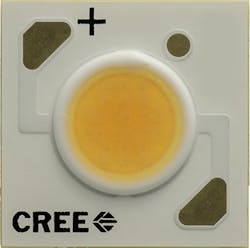Cree launches new COB LED arrays with 33% efficacy gain
Using elements of the Cree SC5 LED technology platform, the CXA2 series of COB LEDs will enable reductions in system cost and size.
Leading into the Strategies in Light conference next week in Las Vegas, Cree has announced the CXA2 series of chip-on-board (COB) LEDs that deliver 33% greater efficacy compared to the prior CXA series products in similar form factors. Cree expects the LEDs to find usage in directional applications such as tracklights and downlights along with outdoor applications that can leverage the gains in flux output.
Paul Scheidt, LED component product marketing lead at Cree, said the new array series uses elements of the Cree SC5 (silicon carbide 5) technology platform announced late last year. Specifically, the CXA2 arrays will get the benefits of emitters with greater flux output, as well as improvements in reliability and color consistency. But the COB LEDs use vastly different packaging and phosphor-deposition schemes relative to SC5 LEDs such as the recently introduced XHP50 and XHP70 LEDs in discrete packages.
The CXA2 LEDs deliver a 15–20% gain in efficacy relative to the prior CXA LEDs at binning current, according to Scheidt. But the new products are able to work at higher current levels more reliably. Scheidt said the efficacy advantage stretches to 25–33% at maximum current.
Cree is releasing the CXA2 family across the range of LEDs with the light-emitting surface (LES) spanning 6 to 30 mm. Indeed, the new products that will carry a CXB prefix will refresh every LES group in the CXA family.
Scheidt stressed that the real advantage is enabling the reduction in system cost and size that comes with more light from a smaller source. He specifically compared a prior-generation CXA2540 with a 19-mm LED to a new CXB1820 with a 12-mm LES. The new, smaller LED delivers 3853 lm at 900 mA while the older product delivers 3790 lm, both at 3000K CCT and 80 CRI. Scheidt said in addition to the obvious size reduction, the new family can deliver 60% system cost savings based on reductions in mechanical and optical components of a lamp or luminaire. Of course, the options also include boosting the performance of existing lighting products by upgrading the design with a CXA2 LED of the same size as the prior CXA LED.
With the CXA2 series introduction, Cree is also taking advantage of guidelines published by the US Environmental Protection Agency (EPA) relative to LM-80 ratings of LEDs with regard to Energy Star recognition. The guidelines allow Cree to utilize LM-80 data gained from tests of the prior-generation LEDs for lighting manufacturers seeking immediate Energy Star approval of CXA2-based products. Meanwhile, Cree has already begun actual LM-80 testing on the new COB LED family.
Cree has made a couple of additional changes in introducing the new COB products. The company will only offer 2- and 3-step MacAdam ellipse bins at CCTs of 3500K and warmer. Cree said the demand is in that tighter lumen and color control range and that the manufacturing process supports that yield. The company will offer 3- and 5-step bins at cooler CCTs.
The company will offer 90-CRI LEDs at 5000K and below, 80-CRI LEDs across the range from 2700K to 6500K, and 70-CRI LEDs at 4000K and above. Cree will no longer offer a 93-CRI option at warm CCTs. Scheidt said, "There is not a whole lot of interest in the 93-CRI option."

Maury Wright | Editor in Chief
Maury Wright is an electronics engineer turned technology journalist, who has focused specifically on the LED & Lighting industry for the past decade. Wright first wrote for LEDs Magazine as a contractor in 2010, and took over as Editor-in-Chief in 2012. He has broad experience in technology areas ranging from microprocessors to digital media to wireless networks that he gained over 30 years in the trade press. Wright has experience running global editorial operations, such as during his tenure as worldwide editorial director of EDN Magazine, and has been instrumental in launching publication websites going back to the earliest days of the Internet. Wright has won numerous industry awards, including multiple ASBPE national awards for B2B journalism excellence, and has received finalist recognition for LEDs Magazine in the FOLIO Eddie Awards. He received a BS in electrical engineering from Auburn University.






